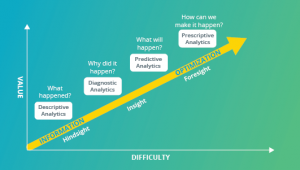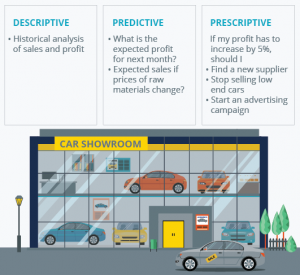Descriptive Analytics and Predictive Analytics have been around the corner for quite a while now. Descriptive Analytics involved looking into the past, from one minute ago to several years ago. The objective was to answer the question, “What has happened within our organization?” Similarly, Predictive Analytics involves looking at vast amounts of Historic and present Data to make predictions about the future (Forecasting). If we see descriptive analytics as the foundation of Business Intelligence and we see predictive analytics as the basis of Big Data, than we can state that prescriptive analytics will be the future of Big Data. So what exactly is Prescriptive Analytics?
 Prescriptive analytics has been one of the largest Big-Data buzzwords in recent years. Being able to automatically prescribe actions in order to attain some goal would mean a huge step forward in decision support or automatic decision making for any field. According to Wikipedia, Prescriptive analytics not only anticipates what will happen and when will it happen, but also why will it happen. Further, prescriptive analytics suggests decision options on how to take advantage of a future opportunity or mitigate a future risk and shows the implication of each decision option. Prescriptive analytics can continually take in new data to re-predict and re-prescribe, this automatically improving prediction accuracy and prescribing better decision options.
Prescriptive analytics has been one of the largest Big-Data buzzwords in recent years. Being able to automatically prescribe actions in order to attain some goal would mean a huge step forward in decision support or automatic decision making for any field. According to Wikipedia, Prescriptive analytics not only anticipates what will happen and when will it happen, but also why will it happen. Further, prescriptive analytics suggests decision options on how to take advantage of a future opportunity or mitigate a future risk and shows the implication of each decision option. Prescriptive analytics can continually take in new data to re-predict and re-prescribe, this automatically improving prediction accuracy and prescribing better decision options.
Despite being relatively new, prescriptive analytics promises to be extremely powerful and accurate in its predictions. Prescriptive algorithms use a huge variety of techniques, such as machine learning, artificial intelligence, and mathematical sciences, to understand the impact of future decisions and adjust actual decisions based on that outcome. One of the most well-known examples of prescriptive analytics is the Google’s new self-driving car. During every trip, it makes multiple decisions about what to do based on predictions of future outcomes. For example, when approaching an intersection, the car needs to determine whether to go left or right and, based on various future possibilities, it makes a decision. So, the car needs to anticipate what might be coming in terms of traffic, pedestrians, etc. and the effect of a possible decision before actually making that decision.

Imagine that a car seller wants to get some insight in his Business. First, he starts with some descriptive analytics and calculates the number of sales and profit he made in the past 5 years. He also defines some cohorts of interest. Then, he moves on to predictive analytics and calculates what his expected profit is for the next month, based on the current and past situation. He also calculates a more advance prediction, such as the expected number of sales if the supplier prices go up five percent. In the prescriptive analytics case, the car seller goes one step further. He wants to increase his total profit by five percent and wants to know what he should do; should he a) find a new supplier, b) stop selling low-end cars, or c) start an advertising campaign.
Prescriptive analytics are relatively complex to administer, and most companies are not yet using them in their daily course of business. When implemented correctly, they can have a large impact on how businesses make decisions. Larger companies are successfully using prescriptive analytics to optimize production, scheduling and inventory in the supply chain to make sure that they are delivering the right products at the right time and optimizing the customer experience.
Combining so many different data sets can also be used to offer doctors recommendations in the best possible treatment for a patient. Thanks to combining and analysing multiple data sets, a Health Care Center was able to improve healthcare and reduce re-admission rates by 10%, thereby saving $ 6 million annually. Also pharmaceutical organizations can benefit from prescriptive analytics by improving their drug development and reduce time-to-market for new medicines. Drugs simulations can improve medicines faster and it becomes easier to find the right patient for clinical trials based on multiple variables.
Prescriptive analytics is the future of Big Data, but it is still a long way away before it will be common language. The potential is enormous, but it also requires massive amounts of data to be able to make correct decisions. Only a handful of organizations and industries have that amount of data and data sets to make something useful out of it with prescriptive analytics. However, in 5-10 years will be as normal as Business Intelligence today.
